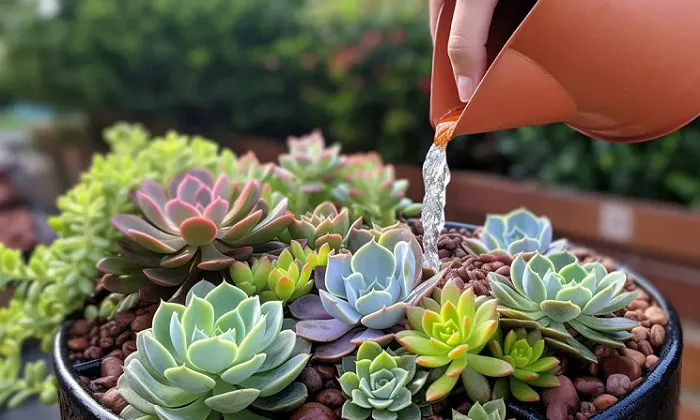Succulents are some of the most resilient and visually striking plants, but their watering needs can be tricky. Too much water leads to rot, while too little causes dehydration. Understanding the right balance is key to keeping them healthy. This in-depth guide covers everything—from watering frequency and techniques to seasonal adjustments and troubleshooting. Whether you’re a beginner or an experienced gardener, these tips will help your succulents thrive.
Let’s explore the best practices for watering succulents the right way.
Why Succulents Need Special Watering Care
Unlike most houseplants, succulents store water in their leaves, stems, or roots. This adaptation helps them survive in arid climates but makes them sensitive to improper watering.
Key Differences Between Succulents and Other Plants
- Water Storage: Succulents retain moisture, so they need less frequent watering.
- Root Sensitivity: Their roots rot easily in soggy soil.
- Drought Tolerance: They can survive dry spells but still need hydration.
Understanding these traits is the first step to proper care.
How Often Should You Water Succulents?
There’s no one-size-fits-all answer—watering frequency depends on several factors.
Factors That Affect Watering Needs
Climate & Season
- Summer (Active Growth): Water every 7–10 days.
- Winter (Dormant Phase): Reduce to every 2–4 weeks.
Indoor vs. Outdoor Succulents
- Indoor: Slower evaporation = less frequent watering.
- Outdoor: More sun and wind = more frequent watering.
Pot Type & Soil
Terracotta pots dry out faster than plastic or ceramic.
Well-draining soil (cactus mix + perlite) prevents overwatering.
The Finger Test: When to Water
Insert your finger 1–2 inches into the soil.
If it’s completely dry, it’s time to water.
If it’s still damp, wait a few more days.
The 3 Best Watering Techniques for Succulents
1. The Soak-and-Dry Method (Most Recommended)
Step 1: Water thoroughly until excess drains from the bottom.
Step 2: Let the soil dry completely before watering again.
Why It Works: Mimics natural desert rainfall, encouraging deep root growth.
2. Bottom Watering (Great for Sensitive Succulents)
Place the pot in a shallow water tray for 15–20 minutes.
The soil absorbs moisture from below, preventing leaf rot.
Best for succulents with delicate leaves (e.g., String of Pearls).
3. Avoiding Mist & Spray Bottles
Misting encourages shallow roots and fungal growth.
Always water the soil directly, not the leaves.
Watering Different Types of Succulents
Not all succulents have the same needs. Here’s a quick breakdown:
| Succulent Type | Watering Needs | Special Tips |
|---|---|---|
| Echeveria | Every 7–10 days in summer | Avoid wetting rosettes to prevent rot |
| Haworthia | Every 10–14 days | Tolerates slight under-watering |
| Sedum (Burro’s Tail) | Every 7 days in heat | Let soil dry between waterings |
| Cacti | Every 2–3 weeks | Almost no water in winter |
| Aloe Vera | Every 10–14 days | Water deeply but infrequently |
Common Watering Mistakes & How to Fix Them
1. Overwatering (The #1 Killer of Succulents)
Signs: Yellow, mushy leaves, black stems.
Fix: Stop watering, repot in dry soil, trim rotten roots.
2. Underwatering (Shriveling & Wrinkles)
Signs: Dry, crispy leaves, slow growth.
Fix: Soak the soil thoroughly, then adjust schedule.
3. Using the Wrong Soil
Problem: Regular potting mix stays wet too long.
Solution: Use a gritty mix (50% cactus soil + 50% perlite/pumice).
Seasonal Watering Adjustments
Summer (Active Growth Season)
Water more frequently (every 7–10 days).
Best time to water: Early morning to prevent evaporation.
Winter (Dormant Phase)
Reduce watering (every 2–4 weeks).
Avoid cold drafts—succulents dislike freezing temperatures.
Conclusion
Watering succulents correctly is the key to their survival. The golden rule? Less is more. Always check the soil, adjust for seasons, and avoid common mistakes like overwatering. With these tips, your succulents will stay vibrant and healthy for years.Now, grab your watering can and give your plants the perfect drink—they’ll thank you with lush, beautiful growth!
FAQs About Watering Succulents
1. Can I Use Tap Water for Succulents?
Yes, but let it sit for 24 hours to evaporate chlorine.
Better options: Rainwater or distilled water.
2. Should I Water After Repotting?
No! Wait 3–5 days to prevent root rot.
3. How Do I Know If My Succulent Is Thirsty?
Soft, wrinkled leaves = Needs water.
Firm, plump leaves = Still hydrated.
4. Can a Dying Succulent Be Saved?
If overwatered: Repot in dry soil, trim rot.
If underwatered: Soak thoroughly, then adjust care.


